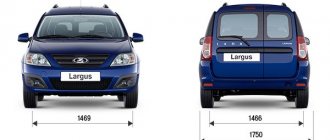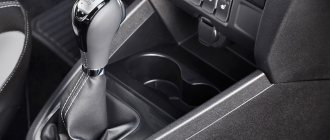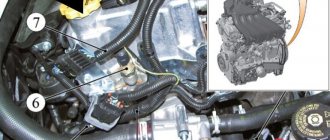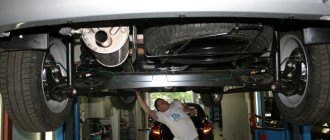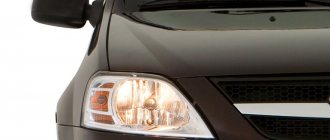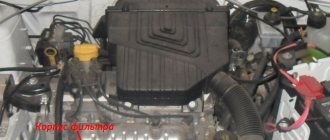In order not to lag behind the recognized leaders of the global automotive industry, at the dawn of the new century, the domestic industry began to think about changing strategic goals and searching for ways of promising development. Mutual cooperation was established not only with European brands, but also with Asian progressive companies.
One of the noteworthy results was the appearance of the practical station wagon Lada Largus, which has French roots from Renault. The first appearance in public caused a storm of attention, which prompted the Russian auto giant not to slow down in this direction. The next step was to modernize the station wagon by installing an automatic transmission.
These days, the Lada Largus equipped with an automatic transmission enjoys considerable popularity. This was achieved thanks not only to its attractive exterior, but also to its confident dynamics. Comfort was also excellent, because if you have an automatic transmission, it’s more convenient to move around the city.
Story
The original station wagon based on the first Logan went into mass production in 2006, and a couple of years later the car was restyled. A descendant under the Lada brand, namely the Largus model, was presented in 2011. Largus entered mass production in 2012. The following year, the second generation Logan MCV appeared. At the same time, Largus has not yet undergone large-scale restyling, which, however, has little effect on its popularity. In 2015, Largus received a Cross modification, which the prototype does not have.
Options and prices
| Front seat belts with force limiter |
| Rear seat headrests |
| ISOFIX child seat anchors |
| Locking the rear doors against opening by children |
| Immobilizer |
| Mechanical headlight corrector |
| Driver airbag |
| Anti-lock brake system (ABS) |
| Front passenger airbag with deactivation function |
| Fog lights |
| One-piece second row seat |
| Fabric seat upholstery |
| 12V socket |
| Luggage compartment lighting |
| Driver's tools: jack, combination wheel wrench, towing eye |
| Second row split seat (1/3 and 2/3 layout) |
| Passenger sun visor with mirror |
| On-board computer |
| Luggage rack on the roof lining |
| Trunk curtain shelf |
| Glove compartment lighting |
| Leather-wrapped steering wheel |
| Height-adjustable steering column |
| Audio preparation |
| Power steering |
| Adjusting the height of the front seat belts |
| Light window tinting |
| central locking |
| Power windows for front doors |
| Heated front seats |
| Air conditioner |
| Driver's seat with height adjustment and lumbar support |
| Central locking with remote control |
| Power windows for rear doors |
| Electric drive and heated exterior mirrors |
| Parking sensors |
| Audio system (FM, CD, MP3, AUX, USB, Bluetooth, Hands free), external antenna |
| 4 speakers |
| Wheels stamped 15" |
| Spare wheel stamped full size 15" |
| Bumpers in body color |
| Side door moldings |
| Exterior mirrors in body color |
| Exterior door handles in body color |
| Railings |
| Cast wheels 15" |
Body
Lada Largus is available in two body styles: station wagon and van. It should be noted that the first Logan had a station wagon (MCV) body, and the van was produced under the name Logan Van.
In comparison with the Logan sedan, this model received an increase in height and wheelbase by 100 and 270 mm, respectively. The length of the car is 4.45 m, width – 1.74 m, height – 1.64 m. The wheelbase is 2.9 m, the track is 1.48 m in the front and 1.47 m in the rear. That is, the car is very large for segment B.
Due to the fact that the original car was initially well adapted to local conditions, its design underwent minimal changes during adaptation. Thus, the treatment area with anti-gravel and anti-noise mastic was expanded, linings were installed on the arches and air ducts for the passenger rows of seats, and the washer fluid tank was increased to 5 liters.
The Cross modification is presented in passenger versions. Externally, it is distinguished by bumpers, arch trims and sills made of unpainted plastic, as well as black pillars.
Gearbox for LADA Largus
The LADA Largus station wagon (2012 - present) is positioned by the manufacturer as a multifunctional car and is offered to potential buyers in three body styles:
- 5-seater passenger;
- 7-seater passenger;
- 2-seater cargo van.
Moreover, it can be used both as a family and commercial vehicle.
Depending on the configuration, LADA Largus engines are equipped with one of two identical 5-speed manual transmissions:
- JH3 – 5-seater passenger cars equipped with a K7M engine.
- JR5 - station wagons (passenger and cargo) in all other trim levels.
Both boxes are adapted to work in difficult climatic and road conditions characteristic of Russia and the CIS countries.
Important! During assembly, transmission oil is poured into the crankcase, which is designed for the entire service life of the LADA Largus vehicle. In this regard, during maintenance and routine maintenance, oil changes are not required.
Gearbox device
The operating principle of all manual gearboxes is almost the same and consists of pairwise connection of gears with different numbers of teeth. Its task is to ensure a change in torque proportional to the gear ratio. At the same time, different car engines have different power, which forces designers to calculate gear ratios and the number of teeth on gears for each model separately.
Reference! The gear ratio is the ratio of the number of teeth of the driven/drive gears.
The table of gear ratios of the gearbox of the LADA Largus car is given in the table:
The design of the gearbox that powers the power units of the LADA Largus station wagon is almost the same. It is based on a two-shaft circuit with synchronizers for all forward gears. This scheme provides for the presence of two parallel shafts, one of which is driving, and the second is driven. During operation, torque from the input shaft gear is transmitted to the desired secondary shaft gear, which is fixed by a synchronizer. A twin-shaft gearbox can have 4 or more forward gears. The principle of its operation is demonstrated in the video:
The main advantage of the two-shaft design is the possibility of constructively combining the engine and transmission into a compact power unit. However, when implementing such a scheme, it is technically impossible to implement direct transmission, which limits its use in heavy vehicles. It is used in front- and rear-wheel drive passenger cars or heavy motorcycles.
Differences between JH3 and JR5 gearboxes
Despite the structural similarity, the gearboxes of the LADA Largus station wagon have a number of significant differences. In addition to different gear ratios, they are organized differently:
- drive wheel drive connections;
- speed selection;
- disengaging the clutch;
- connection of driving wheels.
Clutch on/off unit:
- The clutch in the JH3 gearbox is engaged/disengaged using a clutch with a bearing, which is moved by a special fork along a guide sleeve. In this case, the latter is connected by a cable to the clutch pedal.
- In the JR5 gearbox, the process of engaging/disengaging the clutch is carried out by a working hydraulic cylinder combined with the clutch release bearing. The working cylinder is connected to the main hydraulic cylinder by a separate pipeline. The clutch pedal acts on the master cylinder rod.
The speed selection in the JH3 gearbox is controlled by a rigid rod, while in the JR5 it is controlled by two flexible cables.
Engine
Initially, Lada Largus was equipped with two imported Renault gasoline four-cylinder engines, including the K7M and K4M.
The K7M is an 8-valve 1.6-liter engine capable of producing up to 86 horsepower at 5,500 rpm and 128 Nm of torque at 3,000 rpm.
K4M is a 16-valve engine of the same displacement. But it is capable of developing up to 102 hp. With. at 5700 rpm and 145 Nm at 3750 rpm.
The first engine was supplied from Romania, the second from Portugal, and since 2013 it began to be assembled under license. A little later, these motors were replaced with their own analogues.
One of them was the VAZ-11189. This is an 8-valve 1.6-liter engine. Develops up to 87 hp. With. power and 140 Nm of torque at 5100 and 3800 rpm, respectively. This engine has been installed since 2015 instead of the K7M.
The second analogue was taken from a VAZ-21129. This is also a 16-valve 1.6-liter engine. Has a power of 106 hp. With. and torque of 148 Nm at 5800 and 4200 rpm, respectively. In 2022 they replaced the K4M.
Unlike Renault analogues, these engines are configured for 92-octane gasoline. It should be noted that Logan MCV and Van, in addition to the above, were equipped with two more engines: a 1.4-liter K7J and a 1.5-liter K9K diesel. However, it was decided not to use them for Largus. The Cross version is equipped only with a 16-valve engine.
Review of LADA Largus station wagon
LADA Largus station wagon. Will take over everything
A pickup truck based on the Lada Largus may appear in Russia this summer. Largus pickup. Largus pickup. Largus pickup
LADA Largus station wagon is an outstanding capacity and high quality workmanship, increased ground clearance and special body protection.
For traveling. For work. For a thousand things
LADA Largus station wagon is a comfortable and roomy car for the city, active countryside recreation and business trips.
It is created as a universal transport capable of performing many tasks “excellently”.
Interior: convenience in every detail
Thanks to the sophisticated power structure of the body and modern safety systems, the LADA Largus station wagon meets the current European requirements for the protection of the driver, passengers and pedestrians.
The station wagon's interior is practical and comfortable: large buttons, good-quality handles, durable fabric. These qualities are emphasized by the general style of the interior, in which silver elements are used.
Practicality and comfort in every detail
LADA Largus station wagon is ready to please passengers with comfortable wide seats. The driver's seat is equipped with height adjustment and lumbar support - this provides a comfortable fit for the driver of almost any size.
LADA Largus is unique in that truly comfortable seats have been created for passengers in the third row: passengers above average height feel free here. LADA Largus is perfectly adapted to the Russian climate: each of the three rows of seats is equipped with air ducts for heating the feet.
Functionality beyond the usual
The name Largus means “generous” in Latin, which speaks of the car’s wide capabilities. LADA Largus offers many options for transforming the interior.
Safety by design
Thanks to the sophisticated power structure of the body and modern safety systems, the LADA Largus station wagon meets the current European requirements for the protection of the driver, passengers and pedestrians.
Rear parking sensors
Reliable insurance when maneuvering in reverse
Superiority Technique
Largus is not only a comfortable, energy-intensive suspension. LADA Largus station wagon is a dynamic car capable of solving many problems. When speed is required, it can accelerate quickly even when fully loaded. This is facilitated by specially selected gear ratios in the transmission. When the driver expects confident maneuvers from Largus, the car proves that it can obediently follow steering movements. Reliability and versatility – this is the philosophy of LADA Largus.
Modern economical engines
There are two engines available for LADA Largus, which allow you to choose a car to suit your taste and goals. Powerful and dynamic, 1.6 l (106 hp), 16-valve engine - for high-speed driving, and high-torque, 1.6 l (87 hp), 8-valve - the optimal solution for economical movement of heavy objects .
Transmission
All modifications of the Logan MCV and Van were equipped with a 5-speed manual transmission from Renault models JH3 and JR5. Drive – front. Largus retained the same transmission layout.
From the moment the model appeared, the question arose about equipping the Largus with an automatic rifle. Moreover, the engines originally installed on it are combined with automatic transmissions on other models, including Logan. In addition, at that time there were plans to equip other VAZ models, except for the Largus, with an automatic transmission. For example, on the first generation Granta with a VAZ-11186 engine, a Jatco automatic transmission was installed.
However, the head of development based on the B0 platform noted that it was not initially planned to configure the Lada-Largus with an automatic transmission. He explained this for several reasons. First of all, on budget models such as Largus, an automatic machine will significantly increase the cost. Even the original model was not equipped with such a transmission. Moreover, the manufacturer was unable to find a third-party automatic transmission suitable for the price for the Largus. This was due to the very large mass of the car. In view of this, at a low cost, the automatic transmission on the Largus should be very powerful.
There are still prospects for the appearance of automatic transmission on this model. Thus, with the release of Vesta in 2015, an automated manual transmission of its own design, the VAZ-21827 AMT, appeared. On this model it is combined with the VAZ-21129 engine, just like on the X-Ray released at the same time, built on the same B0 platform as Largus. Moreover, the difference in weight between the two models is small.
It should be noted that there was an advertisement on the Internet for the sale of a Lada-Largus-Cross automatic. However, the origin of this car is unknown. As standard, like the regular Largus, the Largus-Cross was not equipped with an automatic rifle.
Exterior
Replacing headlight bulbs for Lada Largus
Taking a first look at the Lada Largus station wagon, the user will immediately notice that this car looks very similar to the Renault Logan. These two cars differ only in the radiator grille and the size of the rims.
The Lada Largus station wagon has a high-capacity trunk, which is closed with two doors, like on the Renault Logan. A well-thought-out design of the luggage compartment allows you to transport a large amount of cargo, including oversized cargo.
The front part of the Lada Largus station wagon looks very aesthetically pleasing, has a stylish radiator grille, in the center of which is the unchanged AvtoVAZ logo. This car model is equipped with advanced optics, which have a teardrop shape. It is the optics of this shape that give the car some aggressive features. In order to increase the load capacity, roof rails are installed on the roof of the Lada Largus station wagon, which allows you to transport additional cargo on the roof of the car. The design of the roof rails is well thought out, and they can easily be called an additional decoration of the car.
Interior
As noted, Largus has several interior layout options.
Passenger modifications are represented by a 5- and 7-seater station wagon. The first has a trunk volume of 560 liters, the second - 135 liters. In both cases, its volume can be increased to 2,350 liters.
The cargo version has two seats and a luggage compartment with a volume of 2,540 liters. However, it retains the rear side doors, allowing access to the trunk from both sides and the rear.
It was the cargo-passenger capabilities at a low cost that determined the success of the model. You can’t even buy a new 5-seater station wagon for that price, not to mention 7-seater cars. Crossovers are much more expensive, and there are almost no minivans in our market. As for the van, foreign analogues are also much more expensive.
Lada Largus Station wagon 5 seats
5 advantages and one big disadvantage of the Lada Largus
This variation of the car is truly family-friendly. This choice allows us to fully ensure the safety of people. The car is equipped with side and front airbags and an ABS system. The model is also reinforced with additional steel profiles. Both the driver and passengers can feel calm and confident inside the car. Lada Largus is able to maintain a smooth ride and excellent maneuverability even on uneven roads with potholes and holes.
The Lada Largus 5-seater configuration includes a 1.6-liter engine (8/16 valves, producing 82/104 hp), which makes you feel comfortable behind the wheel. The power of this model meets all modern requirements.
In addition to its pleasant appearance, power and maneuverability, such a station wagon is also economical. Fuel consumption in the combined cycle is only 7.5-8 liters per 100 km.
It is worth mentioning the interior design of the 5-seater model. It is roomy enough for a family with even the most restless little ones. Ergonomic seats will be appreciated by even the most demanding and capricious passengers. Drivers will certainly enjoy the comfortable steering wheel and well-designed instrument panel. All elements of the interior are designed in the same style and the result is an overall harmonious design.
Of course, a large family most often transports a lot of things, especially when traveling on vacation. Having purchased a Lada Largus, there will be no problem with trunk capacity. The five-seater version has a trunk volume of 560 liters. This is even more than enough to transport almost any luggage.
It is also worth noting that the five-seater station wagon of the “Norma” variation has tinted windows, power steering, a driver’s airbag, power windows, interior and trunk lamps. The child seat fastening system will please parents and ensure the safety of the child on the road.
The Luxury package is somewhat wider and also includes a front passenger airbag, fog lights, electrically heated and electrically adjustable exterior mirrors, heated seats, and air conditioning.
Prices for a five-seater Lada Largus, depending on its class and configuration, range from 496,000 to 593,200 rubles.
The five-seater Lada Largus has a length of 4470 m, a width of 1750 m and a height of 1636 m. The body type is station wagon. The car is front-wheel drive with a front transverse engine. The engine is four-stroke with a displacement of 1598 cc. Type of fuel: unleaded gasoline AI-95. Transmission: five-speed manual. The maximum speed that such a car can reach is 165 km/h. Number of doors – 6. The power system involves distributed injection with electronic control. Fuel consumption in the combined cycle is an average of 9.0 liters.
Reviews
Owners evaluate the car differently. They like, first of all, the cargo-passenger parameters - the spaciousness of the cabin and trunk. They also note the high seating position, which provides good visibility, and the soft suspension, characteristic of cars built on this platform. Many are satisfied with the engine power. They also note that the machine is highly economical and reliable.
An uncomfortable interior is mentioned as disadvantages, namely the low quality of materials used in assembly, poor sound insulation and ergonomics, a small selection of options, among which there are not even the simplest of them. Many people find the gearbox inconvenient due to short gears, which leads to noise and increased fuel consumption. Also, many people lack all-wheel drive for the Lada-Largus automatic and a more powerful engine.
As for repairs, most owners were faced with only planned work. There are no typical weak points noted, with the exception of ball joints and headlight bulbs.
Exterior and interior design of Lada Largus
The appearance of the Lada Largus Station wagon does not differ in any striking features.
It is quite simple and at the same time understandable to many. However, in this regard, AvtoVAZ never tried to amaze its customers. On the other hand, the simple design is explained by the positioning of this model. We are dealing with a “station wagon”, and these have always been primarily simple work cars that are also suitable for the role of a family car. Thus, there is simply no need to make an elaborate design, to give the car an aggressive or overly provocative look. Yes, they are offering us exactly a roomy working “station wagon” that will cope with its tasks perfectly. And only those who will need such a car due to the nature of their activities or for any other reason will purchase it. In any case, the demand for such a car may be quite high among a certain category of motorists. As for the interior design, everything here is also at a fairly high level. Despite the fact that the Lada Largus is a car belonging to the budget segment, the interior decoration is also at a high level, although it cannot be said that it in any way amazes those who get inside. But for all its simplicity, Lada Largus remains at a certain level. In particular, even in the basic configuration, motorists receive air conditioning, an ABS system, airbags for the driver, as well as a functional multimedia system.
Price
The price of the new passenger Largus ranges from 565 to 656 thousand rubles for cars with an 8-valve engine. The cost of 16-valve options starts from 655 thousand and reaches 710 thousand. As for the interior configuration, 7-seater versions can be purchased for a minimum of 641 thousand. The most expensive 5-seater car costs 686 thousand rubles.
The van is a little cheaper. The price for the 8-valve modification ranges from 535 to 610 thousand, and for the 16-valve modification – 630 thousand.
Largus Cross costs from 715 to 740 thousand. On the secondary market you can find cars of various modifications at prices starting from 250 thousand rubles.
AVTOVAZ plans to install a new automatic transmission on the Lada Largus
AVTOVAZ is considering installing a robotic gearbox on the new Lada Largus. More recently, the Lada Granta was released with the same robotic gearbox and now there is a possibility of its installation on Largus.
As the acting director of the project “Cars on the B0 platform” Sergey Korzhanovsky said, in the initial idea Lada Largus did not think about an automatic transmission, since the automaker did not have the necessary transmission with an acceptable cost and a high resource. But the company does not want to completely abandon this idea, and it was decided to soon develop a robotic gearbox for Largus. Sergei Korzhanovsky also said that in the near future it is planned to equip the Lada Largus with new options. The speaker kept silent about what these improvements would be.
Production of Lada Largus station wagons started in April, and first sales began on July 16. The number of people wishing to purchase this car is growing rapidly. Prices start from 376,000 rubles for a five-seater model and from 395,000 rubles for a seven-seater. As previously reported on the Internet portal Kolesa.RU, this Lada Largus model will be the second car with an automatic transmission produced by AVTOVAZ. In July, AVTOVAZ began mass production of the new Lada Granta with an automatic 4-speed transmission, which, by the way, was produced by the Japanese company Jatco (Nissan owns a controlling stake). This box is a modernized version of the unit that was installed more than 20 years ago on the once popular Nissan Sunny.
Thirteen production and, notably, three world premiere automobile models will be officially presented by AVTOVAZ at MIAS-2012. All of the above premieres will be shown at the LADA stand at Crocus Expo. [ad#336×280-for-post .
Today, July 20, 2012, is the 46th anniversary of the largest Russian automaker. On July 20, 1966, a Decree of the USSR Government was signed on the construction of the AVTOVAZ plant in Tolyatti. The plant has been producing cars for 40 years.
At the Moscow Motor Show, the domestic automaker presented its newest concept car - the four-seater crossover LADA XRAY, which was created by a team of young designers led by Steve Mattin. The meaning of LADA XRAY is to show the interior.
From October 25 to 28, the 17th specialized exhibition MOBI 2012 was held in Krasnodar, in which eight LADA cars from AVTOVAZ took part, including the new LADA Kalina model! The debut of the new LADA Kalina took place at the Moscow Automotive Show.
Lada with automatic transmission and Largus - Za Rulem magazine
The new AVTOVAZ model will receive a four-speed automatic transmission from the Japanese Jatco brand. Since the late nineties, this transmission manufacturer has actually been owned by Nissan, which owns 80% of Jatco shares - it is easy to assume that the gearbox was “advised” by shareholders from Renault to Tolyatti residents. However, the unit model RE4F03 has one indisputable advantage - its low price. After all, this box is not one of the modern ones - it was put into production exactly twenty years ago, and since then different versions of it can be found on Nissan models such as Note, Tiida or Almera Classic. Production of Granta with an automatic transmission will begin in the second half of next year, and such cars should arrive to the first buyers at the turn of 2012 and 2013. At the same time, Kalinas with automatic transmission will also appear - this model will receive a new gearbox during the update process. How much the first car in the history of a domestic brand with an automatic transmission will cost is still unknown.
Selector automatic transmission Lada Granta
Selector automatic transmission Lada Granta
At the Interauto exhibition, prices for two of the three trim levels of the Granta model were announced. Already in the simplest configuration, which will be called “Standard”, the Tolyatti new product will receive a driver’s airbag and places for mounting Isofix child seats - the base price of this configuration will be 229,000 rubles. The main bet (according to announced forecasts - up to 70% of sales) AVTOVAZ marketers are making on the average “Norma” package, the buyer of which for 256,000 rubles will receive electric power steering, a height-adjustable steering column, central locking, front electric windows and an on-board computer. In addition, the bumpers of the “Norma” will be painted in the color of the body, while those of the “Standard” are unpainted.
Characteristics
| Wheel formula / drive wheels |
| Engine location |
| Body type / number of doors |
| Length / width / height, mm |
| Base, mm |
| Front/rear wheel track, mm |
| Ground clearance, mm |
| Luggage compartment volume in passenger/cargo… |
| engine's type |
| Supply system |
| Number, arrangement of cylinders |
| Working volume, cubic meters cm |
| Maximum power, hp / kW / rev. min. |
| Maximum torque, Nm / rev. min. |
| Fuel |
| Maximum speed, km/h |
| Acceleration time 0-100 km/h, s |
| Urban cycle, l/100 km |
| Extra-urban cycle, l/100 km |
| Combined cycle, l/100 km |
| Curb weight, kg |
| Total weight, kg |
| Fuel tank volume, l |
| Permissible gross weight of a towed trailer with... |
| Permissible gross weight of the towed trailer without... |
| Transmission type |
| Main gear ratio |
| Front |
| Rear |
| Steering gear |
| Dimension |
Gearbox malfunctions and methods for eliminating them
Any mechanism has a tensile strength, especially if it operates under variable loads. It is necessary to take into account the driver's driving style, which significantly affects the durability of the part. Summarizing the accumulated experience and analysis of breakdowns that occur during the operation of the car, gearbox faults can be grouped into several main groups: noise in the gearbox, difficulty engaging the gear and spontaneous shutdown of the transmission.
Noise and difficulty shifting gears
The main causes of noise in the gearbox include:
- low oil level;
- water entering the system;
- wear of bearings or gears.
To fix the problem, you should add or replace the oil in the gearbox, replace the bearings and gears with new ones.
Difficulty shifting gears can be caused by the following factors:
- faulty gearbox control rod;
- loosening of fastenings;
- deformation of control drive parts;
- wear of synchronization rings;
- incomplete disengagement of the clutch.
The listed faults can easily be eliminated by adjusting the clutch and replacing deformed and worn parts. It also helps to adjust the mechanisms in accordance with the regulations indicated in the car’s operating manual.
Spontaneous transmission shutdown
The reasons for spontaneous shutdown of the gearbox are usually:
- gear wear;
- damage occurs on the rubber supports of the box;
- wear of the synchronizer rings.
These faults can only be corrected by replacing them with new parts. Do-it-yourself transmission repair requires high qualifications and a set of special tools. Only a competent specialist can remove and disassemble this part correctly.
If the gearbox malfunctions, it is better to contact a service station, where they will not only repair the unit, but will also give you a guarantee that you can use in the event of a subsequent gearbox breakdown.
